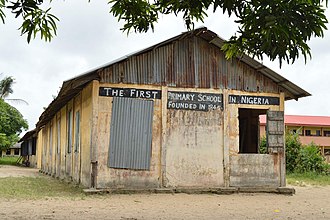

A school is both the educational institution and building designed to provide learning spaces and learning environments for the teaching of students under the direction of teachers. Most countries have systems of formal education, which is sometimes compulsory.[2] In these systems, students progress through a series of schools that can be built and operated by both government and private organization. The names for these schools vary by country (discussed in the Regional terms section below) but generally include primary school for young children and secondary school for teenagers who have completed primary education. An institution where higher education is taught is commonly called a university college or university.
In addition to these core schools, students in a given country may also attend schools before and after primary (elementary in the U.S.) and secondary (middle school in the U.S.) education.[3] Kindergarten or preschool provide some schooling to very young children (typically ages 3–5). University, vocational school, college or seminary may be available after secondary school. A school may be dedicated to one particular field, such as a school of economics or dance. Alternative schools may provide nontraditional curriculum and methods.
Non-government schools, also known as private schools,[4] may be required when the government does not supply adequate or specific educational needs. Other private schools can also be religious, such as Christian schools, gurukula (Hindu schools), madrasa (Arabic schools), hawzas (Shi'i Muslim schools), yeshivas (Jewish schools), and others; or schools that have a higher standard of education or seek to foster other personal achievements. Schools for adults include institutions of corporate training, military education and training and business schools.
Critics of school often accuse the school system of failing to adequately prepare students for their future lives,[5] of encouraging certain temperaments while inhibiting others,[6] of prescribing students exactly what to do, how, when, where and with whom, which would suppress creativity,[7] and of using extrinsic measures such as grades and homework, which would inhibit children's natural curiosity and desire to learn.[8]
In homeschooling and distance education, teaching and learning take place independent from the institution of school or in a virtual school outside a traditional school building, respectively. Schools are organized in several different organizational models, including departmental, small learning communities, academies, integrated, and schools-within-a-school.
- ^ Kuhlmann, Stefan (27 January 2017). Research Handbook on Innovation Governance for Emerging Economies: Towards Better Models. Cheltehnham, UK: Edward Elgar. ISBN 978-1-78347-191-1. OCLC 971520924.
- ^ Roser, Max; Ortiz-Ospina, Esteban (2019). "Primary and Secondary Education". Our World in Data. Archived from the original on 18 May 2023. Retrieved 24 October 2019.
- ^ "Understanding the American Education System". www.studyusa.com. Archived from the original on 9 November 2022. Retrieved 9 November 2022.
- ^ "Indo American Public School (IAPS) | Best School in Udaipur". Archived from the original on 25 February 2019.
- ^ "Schools don't prepare children for life. Here's the education they really need | Rhiannon Lucy Cosslett". The Guardian. 12 June 2017. Archived from the original on 4 August 2021. Retrieved 4 August 2021.
- ^ Keogh, Barbara (9 September 2009). "Why it's important to understand your child's temperament". www.greatschools.org. Archived from the original on 4 August 2021. Retrieved 4 August 2021.
- ^ Robinson, Sir Ken (27 June 2006), Do schools kill creativity?, archived from the original on 15 September 2013, retrieved 4 August 2021
- ^ "'Schools are killing curiosity': why we need to stop telling children to shut up and learn". The Guardian. 28 January 2020. Archived from the original on 4 August 2021. Retrieved 4 August 2021.